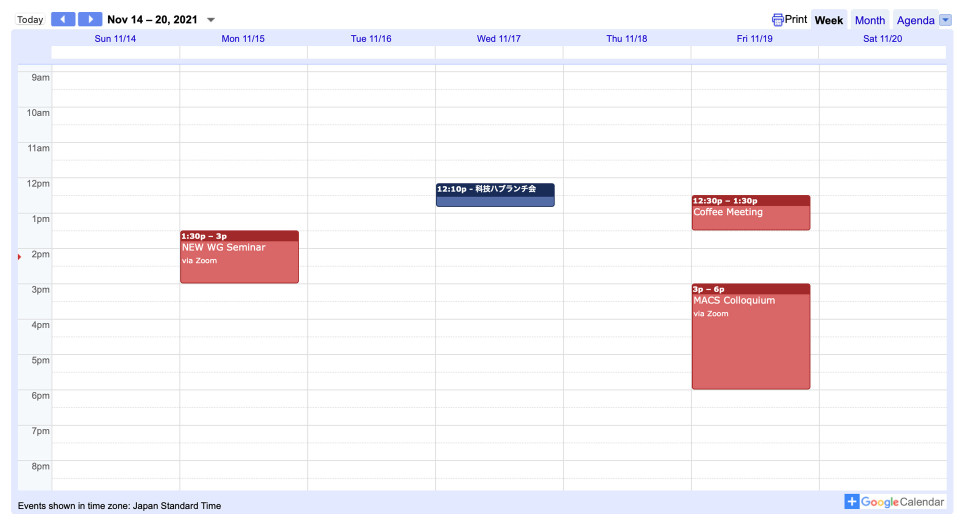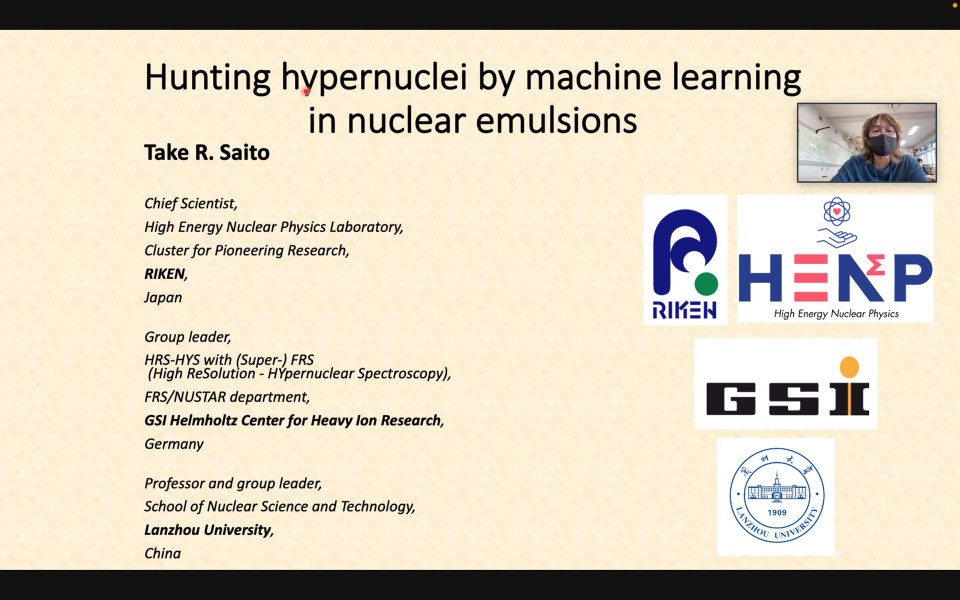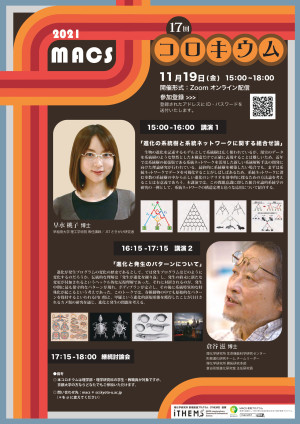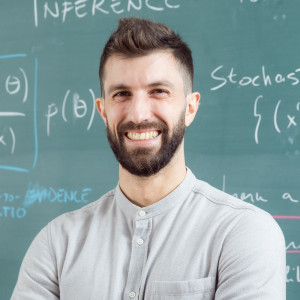Volume 174
Back to Newsletter List
Event Schedule
Events for the 3rd week of November 2021
2021-11-11
Monday, November 15, 13:30– 15:00 NEW WG Seminar
Friday, November 19, 12:30- Coffee Meeting
Friday, November 19, 15:00- 18:00 MACS Colloquium
Seminar Report
iTHEMS Theoretical Physics Seminar by Prof. Katsuki Aoki on November 2, 2021
2021-11-10
On November 2, 2021, at a seminar as part of the iTHEMS-phys seminar series, Dr. Katsuki Aoki (YITP, Kyoto University) delivered a talk on the topic of consistency conditions on the Standard Model of particle physics imposed from the requirements of a more fundamental ultraviolet (UV) theory. Underlying assumptions on UV completion can impose constraints on its low-energy effective field theories (EFTs). The swampland program aims to clarify consistent and inconsistent EFTs with quantum gravity and aims to understand quantum gravity from low-energy physics and vice versa. One of the most well-established constraints is called positivity bounds, provided that general assumptions such as Poincare invariance and unitarity are satisfied at all scales. Dr. Aoki first explained how these consistency conditions arise especially in the presence of gravity. He then showed that the positivity bound is violated if the Standard Model coupled to General Relativity is extrapolated up to 10^16 GeV, requiring new physics there or below. The precise value of the cutoff is determined by hadronic physic while it is insensitive from non-gravitational physics beyond the Standard Model. This is a signal from established physics for the necessity of quantum gravity below 10^16 GeV.
Reported by Ryo Namba
Is the Standard Model in the Swampland? Consistency Requirements from Gravitational Scattering
November 2 (Tue) 14:30 - 16:00, 2021
Seminar Report
Information Theory SG Seminar by Dr. Michiya Mori on November 4, 2021
2021-11-11
On November 4, Dr. Michiya Mori gave a talk entitled “Boolean algebras and operator algebras” at the Information Theory SG Seminar. He explained some of the basic concepts of Boolean algebra. Then he talked about some interesting issues and his contributions in the field. It was a very informative and stimulating talk.
Reported by Yukimi Goto
Boolean algebras and operator algebras
November 4 (Thu) 15:00 - 16:30, 2021
Seminar Report
Astro-AI WG/Information Theory SG Joint Seminar by Dr. Takehiko Saito on November 8, 2021
2021-11-11
The seminar was held online plus 4 people on-site. Dr.Saito gave a talk about “hunting hypernuclei by machine learning in nuclear emulsions”. Recent experimental studies with heavy ion beams have revealed that the nature of the hypertriton is unclear, especially on its biding energy and lifetime. The group led by Dr. Saito conducted measurements of them using nuclear emulsion, which requires a huge human load on visual image analyses. Therefore, they have developed machine learning models to detect events associated with production and decay of hypertriton in nuclear emulsions data, and successfully have discovered hypertriton events.
Reported by Naomi Tsuji
Hunting hypernuclei by machine learning in nuclear emulsions
November 8 (Mon) 14:00 - 15:00, 2021
Upcoming Events
Seminar
ABBL-iTHEMS Joint Astro Seminar
Axions around rotating black holes
November 12 (Fri) 14:00 - 16:00, 2021
Hirotaka Yoshino (Institute of Cosmophysics, Department of Physics, Graduate School of Science, Kobe University)
String theories indicate the existence of many axionlike scalar fields with light masses in addition to the QCD axion. If this is the case, an axion field around a rotating black hole extracts the energy of the black hole by the mechanism called the “superradiant instability”. Then, every astrophysical black hole is expected to wear a cloud of the axion. In this talk, I would like to give an overview on this topic, and introduce our numerical studies on the phenomena caused by the axion cloud at the last stage of the superradiant instability where the self-interaction of axions becomes important.
Venue: via Zoom
Event Official Language: English
Seminar
iTHEMS Math Seminar
Confluence for the K-theoretic J-function
November 12 (Fri) 16:00 - 18:00, 2021
Todor Milanov (Associate Professor, Kavli Institute for the Physics and Mathematics of the Universe (Kavli IPMU), The University of Tokyo)
I am planning to talk about my recent paper (1) written in collaboration with Alexis Roquefeuil. In the first part of the talk I would like to explain the background of our project: quantum differential equations and K-theoretic quantum q-difference equations in genus-0 Gromov--Witten theory. In the second part of the talk, I would like to explain our main result with an interesting application. Namely, under the assumption that the first Chern class of the tangent bundle is positive, we proved that the small J-function in quantum cohomology can be obtained as a limit q -->1 of the small J-function in quantum K-theory. In the case of a Fano toric manifold of Picard rank 2, we proved the K-theoretic version of an identity due to Iritani that relates the I-function of the toric manifold and the oscillatory integral of the toric mirror. In particular, our confluence result yields a new proof of Iritani's identity in the case of a Fano toric manifold of Picard rank 2.
*Please contact Keita Mikami's mail address to get access to the Zoom meeting room.
Reference
- Todor Milanov, Alexis Roquefeuil, Confluence in quantum K-theory of weak Fano manifolds and q-oscillatory integrals for toric manifolds, (2021), arXiv: 2108.08620
Venue: via Zoom
Event Official Language: English
Seminar
NEW WG Seminar
Geometry in optical responses of quantum materials
November 15 (Mon) 13:30 - 15:00, 2021
Naoto Nagaosa (Deputy Director, Group Director, Strong Correlation Theory Research Group, RIKEN Center for Emergent Matter Science (CEMS) / Professor, Department of Applied Physics, Graduate School of Engineering, The University of Tokyo)
Studies on optical responses of solids have the long history, and has been considered to be well established. However, a new development has been on-going recently, which explores the geometric nature of the electronic states in solids and its crucial role in optical processes.
In this talk, I discuss the geometry and topology in the optical responses both in linear and nonlinear regimes, which includes (i) optical responses in clean superconductors, (ii) shift current in noncentrosymmetric quantum materials driven by Berry phases, and (iii) Riemannian geometry in nonlinear optical responses.
References
- J. Ahn and N. Nagaosa, Theory of optical responses in clean multi-band superconductors, Nature Communications 12, 1617 (2021), doi: 10.1038/s41467-021-21905-x
- T. Morimoto and N. Nagaosa, Topological nature of nonlinear optical effects in solids, Science Advances, Vol 2, Issue 5 (2016), doi: 10.1126/sciadv.1501524
- J. Ahn, G.Y, Guo and N.Nagaosa, Low-Frequency Divergence and Quantum Geometry of the Bulk Photovoltaic Effect in Topological Semimetals, Physical Review X, Volume 10, Issue 4 (2020), doi: 10.1103/PhysRevX.10.041041
- J. Ahn, G.Y, Guo, N.Nagaosa, A. Vishwanath, Nature Phys. To appear
Venue: via Zoom
Event Official Language: English
Colloquium
MACS ColloquiumSupported by iTHEMS
The 17th MACS Colloquium
November 19 (Fri) 15:00 - 18:00, 2021
Momoko Hayamizu (Assistant Professor, Faculty of Science and Engineering, School of Fundamental Science and Engineering, Waseda University / PRESTO Researcher, Japan Science and Technology Agency (JST))
Shigeru Kuratani (Chief Scientist, Evolutionary Morphology Laboratory, RIKEN Cluster for Pioneering Research (CPR) / Team Leader, Laboratory for Evolutionary Morphology, RIKEN Center for Biosystems Dynamics Research (BDR))
15:00- Talk by Prof. Momoko Hayamizu
16:15- Talk by Dr. Shigeru Kuratani
17:15- Discussion
Venue: via Zoom
Event Official Language: Japanese
Seminar
Information Theory Seminar
Simulation-based inference for multi-type cortical circuits
November 29 (Mon) 13:30 - 15:00, 2021
Enrico Rinaldi (Research Fellow, Physics Department, University of Michigan, USA)
In many scientific fields, ranging from astrophysics to particle physics and neuroscience, simulators for dynamical systems generate a massive amount of data. One of the crucial tasks scientists are spending their precious time on is comparing observational data to the aforementioned simulations in order to infer physically relevant parameters and their uncertainties, based on the model embedded in the simulator. This poses a problem because the likelihood function for realistic simulations of complex physical systems is intractable. Simulation-based inference techniques attack this problem using machine learning tools and probabilistic programming. I will start with an overview of the problem and explain the general application of simulation-based inference methods. Then I will describe an application of the methods to a model of neurons in the visual cortex of mice."
References
- Kyle Cranmer, Johann Brehmer, Gilles Louppe, The frontier of simulation-based inference, PNAS 117, 48, 30055-30062 (2020), doi: 10.1073/pnas.1912789117
- Agostina Palmigiano, Francesco Fumarola, Daniel P. Mossing, Nataliya Kraynyukova, Hillel Adesnik, Kenneth D. Miller, Structure and variability of optogenetic responses identify the operating regime of cortex (2021), doi: 10.1101/2020.11.11.378729
Venue: via Zoom
Event Official Language: English
Paper of the Week
Week 2, November 2021
2021-11-11
Title: Lefschetz fibrations on the Milnor fibers of cusp and simple elliptic singularities
Author: Naohiko Kasuya, Hiroki Kodama, Yoshihiko Mitsumatsu, Astuhide Mori
arXiv: http://arxiv.org/abs/2111.00749v1
Title: Planckian Physics Comes Into Play At Planckian Distance From Horizon
Author: Pei-Ming Ho, Hikaru Kawai, Yuki Yokokura
arXiv: http://arxiv.org/abs/2111.01967v1
If you would like to cancel your subscription or change your email address,
please let us know via our contact form.
Copyright © iTHEMS, RIKEN. All rights reserved.








